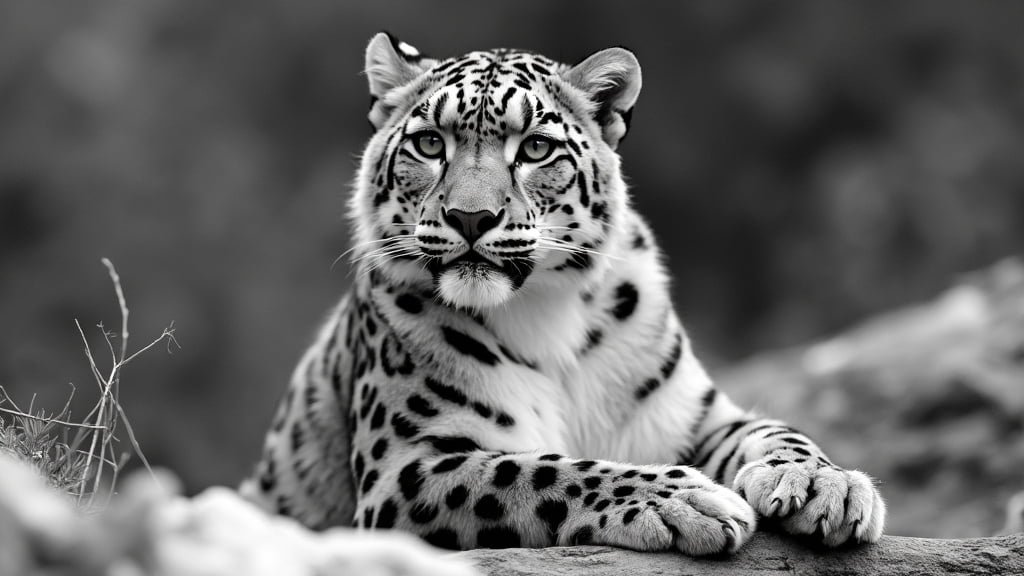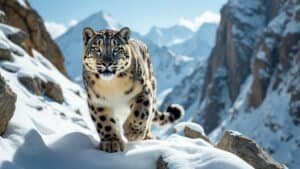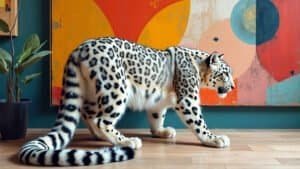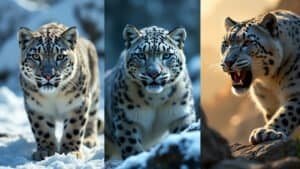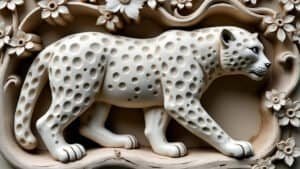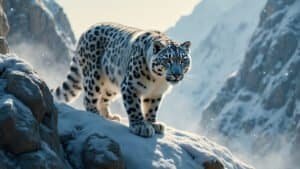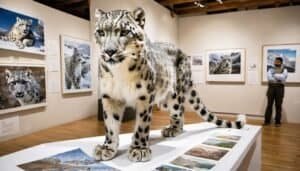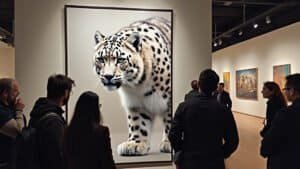Introduction
Photographing snow leopards is a rare and awe-inspiring feat, often requiring immense skill, patience, and knowledge of these elusive cats and their environments
In this article, we will explore some of the most iconic snow leopard photographs ever captured and the remarkable stories behind them. From the challenges faced by photographers to the specific habitats and behaviors of snow leopards that have been documented, this guide will delve into the artistry and effort involved in capturing these majestic creatures on camera
Additionally, we’ll discuss how photography has played a key role in conservation and protection efforts for snow leopards
The Most Iconic Snow Leopard Photographs
Capturing an iconic photograph of a snow leopard requires immense patience, technical skill, and sometimes, luck. These cats are elusive, living in some of the harshest and most remote environments on Earth, often blending seamlessly into their surroundings
Their stunning beauty and rarity have led to some incredible photographs that stand out in the wildlife photography world. These images are not just admired for their aesthetic value but are also celebrated for the stories they tell about these endangered animals and the dedication of photographers to bring them to the world’s attention
What Makes a Snow Leopard Photograph Iconic?
A snow leopard photograph becomes iconic not only because of the animal itself but also due to the circumstances in which the photo is taken
The rarity of the snow leopard, its camouflage in rugged terrain, and the challenging conditions photographers face in capturing the image contribute to its impact
Snow leopards are known for their solitary nature, often roaming alone across vast mountain ranges. A photo that reveals a snow leopard’s majesty, strength, or a rare behavior, such as hunting or interacting with cubs, can become a powerful symbol of wildlife photography
Steve Winter’s snow leopard photograph from the Himalayas is often cited as one of the most iconic. Taken for National Geographic in 2008 after months of patient waiting and using hidden camera traps, this image shows a snow leopard perfectly camouflaged against its rocky surroundings
The photograph highlights both the beauty and stealth of the species, making it a defining moment in wildlife photography. The photograph won Winter numerous awards, and its visibility helped boost global awareness about snow leopard conservation efforts
Famous Photographers Who Captured Iconic Snow Leopard Shots
Many renowned wildlife photographers have dedicated their careers to documenting snow leopards. Steve Winter, a National Geographic photographer, is one of the most celebrated in this field
Winter spent years working in the Himalayas and other regions to capture one of the most iconic images of a snow leopard on a nighttime prowl. His work earned him the BBC Wildlife Photographer of the Year award and brought global attention to snow leopard conservation
Vincent Munier is another famous photographer known for his snow leopard images. Munier’s style blends art and nature, with his photos emphasizing the elusive and mystical qualities of snow leopards in the Tibetan highlands
His work stands out for its minimalistic approach, often showing the snow leopard as a small figure in a vast, snowy landscape, highlighting its solitary existence and the remote environments it calls home
In 2016, David Yarrow captured a striking image of a snow leopard in Mongolia. This photograph, showing the leopard mid-stride in a snowy environment, became one of the most widely recognized wildlife images
Yarrow’s ability to photograph the snow leopard in such a dynamic, natural pose, with incredible clarity and detail, elevated his status as a leading wildlife photographer
Award-Winning Snow Leopard Photographs
Several snow leopard photographs have received prestigious awards, underscoring their significance in wildlife photography
Steve Winter’s 2008 photo series earned him the Wildlife Photographer of the Year award, which is one of the highest honors in the field. His work helped draw attention to the difficulties and triumphs of photographing snow leopards in the wild
In 2021, photographer Sascha Fonseca captured an extraordinary image of a snow leopard through a remote camera trap in the Indian Himalayas. This photograph, showing a snow leopard gazing directly into the camera, won the People’s Choice Award in the Wildlife Photographer of the Year competition
What makes Fonseca’s image particularly iconic is the sharpness of the snow leopard’s gaze, which seems to pierce through the cold, misty atmosphere of the Himalayan landscape. The photograph exemplifies the power of modern technology—using remote cameras to observe wildlife without human interference—while still maintaining the raw beauty of the natural world
These award-winning photos serve not only as beautiful works of art but also as tools for raising awareness about the importance of snow leopard conservation. They offer a glimpse into the life of a species that remains one of the most difficult to photograph in the wild
Challenges Of Photographing Snow Leopards
Photographing snow leopards presents a unique set of challenges due to the elusive nature of the species and the extreme environments they inhabit. Snow leopards are solitary and secretive creatures, often referred to as “ghosts of the mountains” because of how difficult they are to spot
These animals live in remote, rugged landscapes, which can be harsh and dangerous for photographers to navigate. The combination of treacherous terrain, freezing temperatures, and the snow leopard’s natural ability to camouflage makes capturing these cats on camera a daunting task that requires immense patience, expertise, and specialized equipment
Difficulties of Finding Snow Leopards in the Wild
Snow leopards are native to the high-altitude mountain ranges of Central Asia, including the Himalayas, the Altai Mountains, and the Tibetan Plateau. These areas are not only difficult to access but also span across vast, isolated regions
The elevation at which snow leopards live—between 9,800 and 17,000 feet—makes it physically challenging for photographers to work for extended periods. The thin air, extreme cold, and steep terrain are significant obstacles
In addition to the physical challenges, snow leopards are highly elusive and difficult to track. They are nocturnal, most active at dawn and dusk, which requires photographers to operate during low-light conditions
Furthermore, snow leopards have home ranges that can span hundreds of square miles, meaning that even if a photographer knows the general area where a snow leopard resides, actually encountering one can take weeks or even months
One technique often used by photographers is working with local trackers who are familiar with snow leopard behavior. These trackers can identify signs of snow leopards, such as paw prints or scrape marks on rocks. However, even with expert help, many wildlife photographers return home without ever catching a glimpse of a snow leopard
Environmental Conditions of Snow Leopard Habitats
The environmental conditions in snow leopard habitats are among the most challenging for any wildlife photographer
The regions where snow leopards live are characterized by extremely cold temperatures, often dropping to -40 degrees Fahrenheit or lower in winter. Photographers must deal with frostbite, equipment failure due to cold, and the constant risk of avalanches or rock slides in these mountainous areas
Wind and snow are constant factors that can limit visibility and complicate photography. Snowstorms are frequent, and the unpredictable nature of the weather at high altitudes means that clear skies can quickly turn into blizzards. Photographers need to prepare extensively, packing thermal clothing, insulated boots, and specialized gear to keep their equipment functional in freezing temperatures
Moreover, snow leopards are masters of camouflage. Their thick, white-gray coats are perfectly suited to blend in with the rocky, snow-covered terrain, making them almost invisible at times. Even if a snow leopard is nearby, photographers can struggle to spot them through the camera lens, requiring extra vigilance and focus
Equipment Needed for Snow Leopard Photography
Photographing snow leopards requires specialized equipment designed to withstand extreme conditions
One essential tool is a high-quality telephoto lens, which allows photographers to capture close-up images from a distance without disturbing the animal. Since snow leopards are often photographed from hundreds of feet away, lenses with focal lengths of 300mm to 600mm are commonly used
Due to the low-light conditions in snow leopard habitats—especially at dawn and dusk—photographers also need cameras with excellent low-light performance. Cameras that can shoot at high ISO settings while maintaining image clarity are critical. In addition, durable tripods are necessary to stabilize cameras during long waiting periods, especially when using heavy telephoto lenses
Remote camera traps have become an invaluable tool in snow leopard photography. These cameras can be set up in areas where snow leopards are likely to pass, triggered by motion sensors when the animal comes near
Camera traps allow photographers to capture candid images of snow leopards without needing to be physically present, reducing human interference in the natural behavior of the animal. Steve Winter and many other renowned photographers have used camera traps to capture some of the most famous snow leopard images
However, using camera traps requires meticulous preparation. Photographers must carefully select the right locations, often consulting with local experts and wildlife biologists to determine the best spots based on snow leopard behavior and movement patterns
Camera traps must also be weatherproofed and capable of withstanding freezing temperatures, wind, and snow over extended periods
Famous Locations For Snow Leopard Photography
Snow leopards inhabit some of the most remote and rugged landscapes in the world, making location a critical factor in successfully photographing them. These animals are native to the mountain ranges of Central and South Asia, spanning 12 countries and covering millions of square miles
For photographers, understanding the key locations where snow leopards are most commonly found is essential to planning an expedition. The Himalayas, Mongolia, and parts of Central Asia are among the most famous regions for capturing snow leopards on camera, each offering unique challenges and rewards
Himalayas: The Snow Leopard’s Primary Habitat
The Himalayas are perhaps the most famous and iconic location for snow leopard photography. Spanning several countries, including India, Nepal, Bhutan, and China, the Himalayan region is home to one of the largest populations of snow leopards. The mountains’ steep cliffs, deep valleys, and snow-covered peaks create the perfect environment for these big cats
Ladakh, a region in northern India, is particularly well-known for snow leopard sightings. Hemis National Park, located in this region, has become a hotspot for photographers and researchers alike
This protected area is one of the few places where snow leopards can be seen more frequently, although sightings are still rare and require experienced guides. Ladakh’s high altitude and harsh winters make it a challenging environment for photography, but the dramatic landscapes provide a stunning backdrop for those lucky enough to photograph a snow leopard
Another key location in the Himalayas is Nepal, particularly in areas like the Annapurna Conservation Area and the Sagarmatha National Park, which encompasses parts of Mount Everest
These areas are known for their snow leopard populations and are increasingly becoming popular destinations for photographers due to ongoing conservation efforts and research programs
Mongolia and Central Asia: Other Key Locations
Mongolia is another important country for snow leopard photography, particularly the Altai Mountains in the western part of the country. The Altai region is known for its vast, open landscapes and rugged mountains, which provide an ideal habitat for snow leopards
The country’s relatively low human population density and vast wilderness areas make it a prime location for studying and photographing these elusive cats
The Tost Mountains in Mongolia have gained prominence as a conservation success story, where local communities and conservationists have collaborated to protect the snow leopard’s habitat. The area is now recognized as a protected region, and several photographers have managed to capture striking images of snow leopards in the wild here
In Central Asia, Kyrgyzstan and Kazakhstan also provide excellent opportunities for snow leopard photography, though these areas are more difficult to access due to their remoteness and the logistical challenges involved. The Tian Shan mountain range, which extends through both countries, is another snow leopard stronghold
These regions are less frequented by tourists and photographers, offering an untouched landscape where snow leopards can roam without much human interference
Remote Camera Traps: Capturing Elusive Snow Leopards
For many wildlife photographers, using remote camera traps has become one of the most effective ways to photograph snow leopards. These cameras, triggered by motion sensors, are set up in key locations where snow leopards are known to travel, often along narrow mountain ridges or near water sources
Camera traps allow photographers to capture images of snow leopards without needing to be physically present, reducing human presence in their natural habitat and increasing the likelihood of obtaining rare shots
Steve Winter’s use of camera traps in the Himalayas and Central Asia revolutionized the way snow leopards were photographed. His famous image of a snow leopard walking along a cliff edge, perfectly camouflaged in its environment, was taken using a remote camera trap
Winter spent months researching snow leopard behavior and working with local trackers to identify the best locations for setting up his cameras
In addition to minimizing human disturbance, camera traps can capture candid moments of snow leopards in their natural state, such as hunting, resting, or interacting with their cubs
These images provide invaluable insights into snow leopard behavior and have contributed to wildlife research and conservation efforts. The data gathered from camera traps has helped scientists estimate snow leopard populations and map their movements across vast territories
Setting up camera traps in the wild, however, requires careful planning and execution. Photographers must ensure that the cameras are securely placed and protected from the elements, including snowstorms and extreme cold, which can damage equipment. The traps also need to be checked periodically to retrieve the images, a process that often involves trekking back to remote locations
Behavior Of Snow Leopards In Iconic Photos
Capturing snow leopards on camera often involves documenting key aspects of their behavior, from their hunting techniques to their ability to blend into their environment. These behaviors, highlighted in some of the most iconic snow leopard photographs, not only showcase the beauty of the species but also provide important insights into their daily lives
Photographers who manage to capture these moments often spend months observing and waiting for the right opportunity, leading to images that offer a glimpse into the elusive world of these magnificent cats
Hunting Behaviors Captured on Camera
One of the most coveted snow leopard photographs is one that depicts a snow leopard in the midst of a hunt
Snow leopards are carnivorous predators, primarily feeding on blue sheep, ibex, and other mountain-dwelling prey. Their hunting technique is remarkable, as they stalk their prey with stealth and agility, often ambushing from above, using the rugged terrain to their advantage
Several photographers have documented these rare moments of snow leopards in action. In 2017, photographer Inger Vandyke captured a striking series of images showing a snow leopard hunting a Himalayan blue sheep, or bharal, on a steep mountainside
The sequence of photos, taken in the Indian Himalayas, showed the snow leopard’s precise movements as it chased the sheep down a rocky slope, demonstrating its incredible agility and strength. This rare documentation of a snow leopard hunt became one of the most widely recognized photo series of the species in action, shedding light on the cat’s predatory skill in its challenging habitat
Capturing such behaviors requires not only photographic skill but also an in-depth understanding of snow leopard behavior, as well as a great deal of patience
Many photographers collaborate with wildlife researchers and conservationists to study the habits and movement patterns of snow leopards, increasing their chances of capturing a successful hunt
Resting and Camouflage: How Snow Leopards Blend Into Their Environment
Snow leopards are masters of camouflage, and their ability to blend into their surroundings is one of the reasons they are so difficult to photograph
Their thick coats, covered in rosettes and spots, mirror the rocky and snowy terrain of their natural habitat. Some of the most iconic images of snow leopards show them almost invisible against the backdrop of snow and rocks, with only their piercing eyes giving them away
A famous example of this is Steve Winter’s iconic 2008 photograph of a snow leopard resting on a rock ledge in the Himalayas. The snow leopard is so well camouflaged that it takes a moment to even recognize the animal in the photograph
This image became widely celebrated for its artistry and its representation of the snow leopard’s natural stealth. Winter’s use of camera traps enabled him to capture this candid moment, where the snow leopard was completely undisturbed by human presence, resting quietly in its mountainous home
The ability to blend into the environment is a crucial survival skill for snow leopards, both for avoiding detection by prey and for protecting themselves from potential threats. Photographers who are able to capture this trait in their images help convey the mysterious and elusive nature of the species
These photographs, while seemingly simple, often evoke a sense of wonder about how snow leopards can disappear into their landscapes, making them almost ghostlike
Snow Leopard Cubs: Rare Photographic Moments
One of the rarest and most treasured subjects in snow leopard photography is the snow leopard cub. These young cats are seldom seen in the wild due to the secretive nature of their mothers, who keep them hidden in rocky dens to protect them from predators and harsh weather
When photographers do manage to capture images of snow leopard cubs, the result is often iconic due to the rarity and emotional impact of the moment
In 2013, photographer Adam Riley captured one of the few known photographs of snow leopard cubs in the wild. The image, taken in the remote mountains of Kyrgyzstan, shows a mother snow leopard watching over her two young cubs as they explore the rocky terrain
The photograph offers a rare glimpse into the early life of snow leopards, showcasing the bond between mother and cubs and the challenges of survival in the harsh mountain environment
Another famous photograph of snow leopard cubs was taken by photographer Dhritiman Mukherjee in the Himalayas. His image shows a snow leopard cub peeking out from behind a rock, with its mother standing guard nearby
The photograph, which won several wildlife photography awards, became an iconic symbol of snow leopard conservation efforts, highlighting the importance of protecting breeding females and their offspring
These moments, rare as they are, require a combination of persistence, knowledge of snow leopard behavior, and often the use of remote camera traps to capture the animals without disturbing them
Photographs of snow leopard cubs are not only endearing but also critical for raising awareness about the vulnerability of the species, particularly regarding the threats to their survival in the wild
The Role Of Snow Leopard Photography In Conservation
Photography plays a pivotal role in the conservation of snow leopards. By capturing the beauty and elusive nature of these rare big cats, photographers contribute to raising awareness about the challenges snow leopards face in the wild
Snow leopard populations are under constant threat due to habitat loss, poaching, and human-wildlife conflict. Iconic photographs have the power to not only inspire action but also to provide scientific data that aids in monitoring snow leopard populations and understanding their behavior
Over the years, wildlife photographers have collaborated closely with conservation organizations to promote snow leopard protection through powerful visual storytelling
How Photography Raises Awareness for Snow Leopard Conservation
Photographs of snow leopards have a unique ability to draw public attention to the plight of these endangered animals. Snow leopards are notoriously difficult to observe in the wild, and most people will never have the opportunity to see one in person
Through photography, the public can connect with snow leopards and learn about the threats they face. Iconic images published in major platforms like National Geographic, BBC Wildlife, and other conservation-driven media outlets reach millions of people, raising awareness and funding for snow leopard conservation programs
For example, Steve Winter’s award-winning series on snow leopards, published in National Geographic, sparked global interest in snow leopard conservation. His images, which captured the beauty and mystery of snow leopards in the Himalayas, played a significant role in motivating funding for research projects and anti-poaching efforts in the region
The public’s emotional response to these photographs led to an increase in donations and support for organizations working to protect snow leopard habitats
Photography can also help amplify the work of organizations such as the Snow Leopard Trust, Panthera, and the Snow Leopard Conservancy. These groups use photographs in their campaigns to educate the public, highlight conservation successes, and call for action in protecting the species
By telling the story of snow leopards through compelling visuals, photographers inspire both individuals and governments to support conservation initiatives
Contributions of Photographers to Snow Leopard Research
In addition to raising awareness, photography has become an important tool in scientific research on snow leopards. Researchers rely on photographs to track individual snow leopards, estimate population sizes, and monitor their movements across vast mountain ranges
Many conservation projects use camera trap images to study snow leopard behavior and document their presence in areas where they are believed to reside
Photographers often collaborate with wildlife biologists to set up remote cameras in snow leopard habitats. These cameras, equipped with motion sensors, can capture thousands of images over several months without human presence. Camera traps provide invaluable data on snow leopards, including insights into their hunting habits, mating behaviors, and territorial ranges
By studying these images, scientists can identify individual snow leopards based on their unique spot patterns, helping to build a database of known individuals
One notable project is the Snow Leopard Trust’s long-term research in Mongolia’s Tost Mountains. Here, camera traps have been used extensively to monitor the local snow leopard population
The photographs collected have been critical in determining the size and health of the population and have informed conservation strategies to protect these cats from poaching and habitat degradation
Additionally, photographic evidence can help address the issue of human-wildlife conflict. In regions where snow leopards sometimes prey on livestock, camera trap photos can provide data to help local communities develop better strategies for coexisting with the predators, such as building predator-proof corrals
Snow Leopard Population Monitoring Through Photography
Photography has become a key method for monitoring snow leopard populations, especially in remote and inaccessible areas where traditional surveys are not feasible
Remote camera traps, often set up by wildlife photographers and researchers, capture images that help estimate population sizes and track the movements of individual animals. This non-invasive method allows for long-term monitoring without disturbing the animals or their habitats
The Snow Leopard Trust, a leading conservation organization, uses photography to monitor snow leopards across several countries, including Mongolia, India, and Kyrgyzstan. Camera traps set in these regions have provided some of the most accurate data on snow leopard populations, helping scientists understand their population density and distribution
These photographs also reveal insights into the seasonal movement patterns of snow leopards, which can inform conservation actions such as habitat protection and anti-poaching patrols
Moreover, population monitoring through photography has been crucial for international efforts to protect snow leopards under the Global Snow Leopard & Ecosystem Protection Program (GSLEP), a multi-nation initiative aimed at protecting snow leopard habitats
Photographs captured through camera traps have been used as evidence of snow leopard presence, helping to secure protected status for critical habitats across their range
Conclusion
Snow leopard photography not only captures the awe-inspiring beauty of these elusive big cats but also plays a crucial role in their conservation
Iconic photographs, such as those taken by Steve Winter and other renowned wildlife photographers, have raised global awareness about the threats snow leopards face, from poaching to habitat loss
By showcasing snow leopards in their natural environment—whether hunting, blending into rocky terrain, or nurturing their cubs—these images inspire public action and support for conservation efforts
The challenges of photographing snow leopards, from navigating treacherous mountain ranges to operating in sub-zero temperatures, reflect the dedication of photographers committed to documenting this endangered species. Remote camera traps have further revolutionized snow leopard photography, allowing for the capture of candid moments without human interference and contributing valuable data to scientific research
This non-invasive method has become essential in monitoring snow leopard populations, tracking individual animals, and informing conservation strategies
As snow leopard photography continues to evolve, its impact on conservation will likely grow. Through powerful imagery, photographers and conservationists alike are bringing these “ghosts of the mountains” into the global spotlight, ensuring that future generations can continue to marvel at their beauty and fight for their survival
